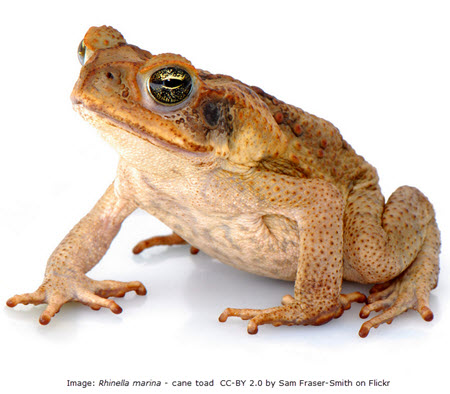Invasive species
 Two short videos introduce students to the problem os invasive species and the cane toad in particular. In a second activity students identify the essential qualities of a species for it to become invasive and then search a database to find another relevant example of an invasive species in their local environment. A few IB style questions complete this activity.
Two short videos introduce students to the problem os invasive species and the cane toad in particular. In a second activity students identify the essential qualities of a species for it to become invasive and then search a database to find another relevant example of an invasive species in their local environment. A few IB style questions complete this activity.
Lesson Description
 Guiding Questions
Guiding Questions
Competition between species takes place in most ecosystems. What resources do species compete for?
Competitive exclusion takes place where one species can't get enough resources, what does this mean?
Activity 1 - Cane toads
Watch the short video ![]() Invasion of the deadly cane toads and
Invasion of the deadly cane toads and ![]() ANM documentary - The cane toad
ANM documentary - The cane toad
Then answer the questions on the short worksheet below.
Answer the questions on this ![]() Cane toad as a model invasive species.
Cane toad as a model invasive species.
Written information to help answer these questions can also be found on the Australian Museum - cane toad information website.
Activity 2 - Research into another invasive species
Look at the following table about the attributes of invasive species.
Summary table showing the qualities of invasive species and two examples.
|
Qualities of invasive species |
Japanese knotweed (Fallopia japonica) |
Cane toad |
|
Alien species have few natural predators. |
Japanese knotweed is not eaten by natural herbivores, like caterpillars. |
The poison it secretes from its glands kills predators reducing predation. |
|
Alien Species have rapid growth, high reproductive rates |
Japanese knotweed grows aggressively by extensive rhizomes forming dense thickets.
|
Females lay thousands of eggs twice a year |
|
Aliens out-compete and displace native species. |
Dense thickets that over-shadow and crowd out native water plants on river banks |
Native frogs only breed once per year. |
|
Alien species dominate an ecosystem, change food webs and reduce biodiversity |
Reduce biodiversity – because there is not enough light for many native species, which grow more slowly. | Predatory monitor lizards, eat cane toads and die resulting in an increase in one of the lizards' typical prey, the crimson finches. |
|
Alien species dominate an ecosystem and cause physical damage |
Japanese knotweed can block waterways, and block public access to stream banks. |
Huge numbers are found at times of the year in Australian towns. |
|
Alien species have an ability to tolerate a wide range of environmental conditions |
Japanese knotweed occupies a wide variety of habitats, e.g. river banks, roadside verges. |
The cane toad has survived the Australian dry season and is known to swim well, and walk long distances at night. |
Research an interesting example of an invasive species in your local environment, using ![]() Invasive species worksheet shown below.
Invasive species worksheet shown below.
- Find your country on this incredible list of invasive species country by country from The Global Invasive Species Database.
- Read the IUCN booklet, 100 of the worst invasive species or click the icons on this Invasive species map by Dr J.T.T. on Thinglink

Extra video inspiration
"Sea grapes" sounds like a tasty snack, not a killer algae. Yet Caulerpa racemosa var. cylindracea poses a serious threat to marine life. ![]() Google earth video intro to sea grapes invasion of the Mediterranean sea.
Google earth video intro to sea grapes invasion of the Mediterranean sea.
![]() Invasive species - Jonathan Birds blue world covers Zebra mussels and Round Gobies in the Great lakes, Lion fish in the Caribbean,
Invasive species - Jonathan Birds blue world covers Zebra mussels and Round Gobies in the Great lakes, Lion fish in the Caribbean,
Activity 3 - IB style question
Test your knowledge with the following![]() IB style question on invasive species
IB style question on invasive species
Teacher's notes
Activity 1 is a simple introduction and could be projected for the class to watch while answering the questions. It introduces the key ideas about invasive species.
In activity 2 students are shown the main characteristics of all invasive species, and then asked to research an extra example of their own. The IB guide requires students to know the example of the cane toad and one other. Examiners will look up any examples given in an exam, but it is best not to choose a very obscure example as this may not be found easily.
On the second side of the worksheet there is space to answer the potential IB question, "Describe the effects of invasive species on ecosystems, using Cane toads and one other example. (4)" This is good practise in formulating a longer IB exam response from several useful bits of information. There are no model answers for this as the table already includes the details for cane toad and there are potentially hundreds of examples. Students must include the name of the species, and one or two effects on ecosystems or the environment, preferable linking the cause and the effect, e.g. "Cane toads poison predators", is not as good as, "Cane toads poison predators which reduces predation allowing faster population growth".
Model answers for the IB style questions can be found here - Invasive species - IB style qns Model Answers Students can be given access or denied access to this page using the "My student groups" link.
Further reading
University of Florida - Cane toad information
National Geographic - Cane toad information
NSW Office of environment and heritage - Cane toads
Debunking myths about Cane toads

 IB Docs (2) Team
IB Docs (2) Team
